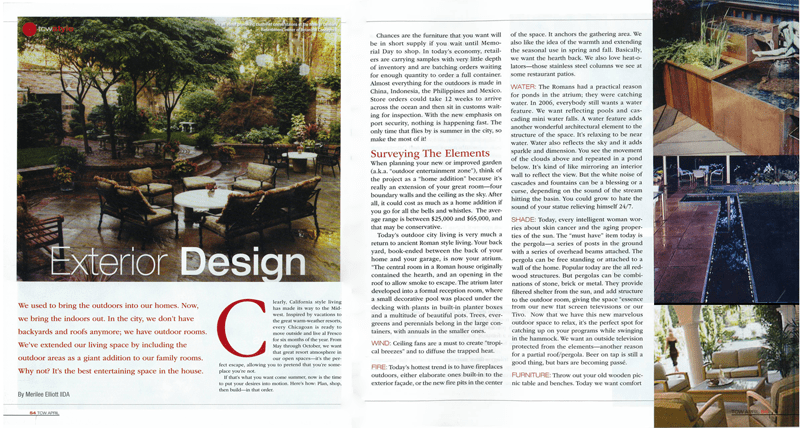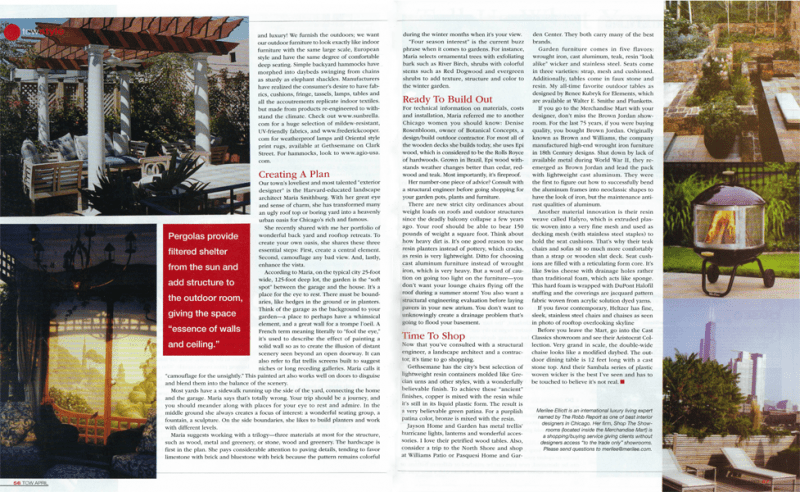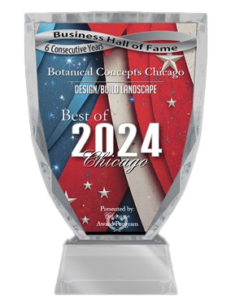Today’s Chicago Woman
April 2006
EXTERIOR DESIGN
By Merilee Elliott IIDA
We used to bring the outdoors into our homes. Now, we bring the indoors out. In the city, we don’t have backyards and roofs anymore; we have outdoor rooms. We’ve extended our living space by including the outdoor areas as a giant addition to our family rooms. Why not? It’s the best entertaining space in the house.
Clearly, California style living has made its way to the Midwest. Inspired by vacations to the great warm-weather resorts, every Chicagoan is ready to move outside and live al Fresco for six months of the year. From May through October, we want that great resort atmosphere in our open spaces – it’s the perfect escape, allowing you to pretend that you’re someplace you’re not.
If that’s what you want come summer, now is the time to put your desires into motion. Here’s how: Plan, shop, then build – in that order.
Chances are the furniture that you want will be in short supply if you wait until Memorial Day to shop. In today’s economy, retailers are carrying samples with very little depth of inventory and are batching orders waiting for enough quantity to order a full container. Almost everything for the outdoors is made in China, Indonesia, the Philippines and Mexico. Store orders could take 12 weeks to arrive across the ocean and then sit in customs waiting for inspection. With the new emphasis on port security, nothing is happening fast. The only time that flies by is summer in the city, so make the most of it.
SURVEYING THE ELEMENTS
When planning your new or improved garden (a.k.a. “outdoor entertainment zone”), think of the project as a “home addition” because it’s really an extension of your great room. – four boundary walls and the ceiling as the sky. After all, it could cost as much as a home addition if you go for all the bells and whistles. The average range is between $25,000 and $65,000, and that may be conservative.
Today’s outdoor city living is very much a return to ancient Roman style living. Your backyard, book-ended between the back of your home and your garage, is now your atrium. “The central room in a Roman house originally contained the hearth, and an opening in the roof to allow smoke to escape. The atrium later developed into a formal reception room, where a small decorative pool was placed under the opening to catch rain water,” according to garden authors Elizabeth Wilkinson and Marjorie Henderson.
So what is it that we want when planning our atrium garden “room”? We want all the conveniences and amenities in our outdoor entertainment zone that we’ve now become used to in our indoor entertainment area. Here’s the new wish list, starting with nature’s basic elements:
EARTH: Container gardens suit the city best. Urban gardeners want most of the area to be hard surface, such as stone, brick or wood decking with plants in built-in planter boxes and a multitude of beautiful pots. Trees, evergreens and perennials belong in the large containers, with annuals in the smaller ones.
WIND: Ceiling fans are a must to create “tropical breezes” and to diffuse the trapped heat.
FIRE: Today’s hottest trend is to have fireplaces outdoors, other elaborate ones built-in to the exterior façade, or the new fire pits in the center of the space. It anchors the gathering area. We also like the idea of the warmth and extending the seasonal use in spring and fall. Basically, we want the hearth back. We also love heat-o-lators – those stainless steel columns we see at some restaurant patios.
WATER: The Romans had a practical reason for ponds in the atrium; they were catching water. In 2006, everybody still wants a water feature. We want reflecting pools and cascading mini water falls. A water feature adds another wonderful architectural elements to the structure of the space. It’s relaxing to be near water. Water also reflects the sky and it adds sparkle and dimension. You see the movement of the clouds above and repeated in a pond below. It’s kind of like mirroring an interior wall to reflect the view. But the white noise of cascades and fountains can be a blessing or a curse, depending on the sound of the stream hitting the basin. You could grow to hate the sound of your statue relieving himself 24/7.
SHADE: Today, every intelligent woman worries about skin cancer and the aging properties of the sun. The “must have” item today is the pergola – a series of posts in the ground with a series of overhead beams attached. The pergola can be free standing or attached to a wall of the home. Popular today are the all redwood structures. But pergolas can be combinations of stone, brick or metal. They provide filtered shelter from the sun, and add structure to the outdoor room, giving the space “essence of wall and ceiling” It’s also good for climbing plants, or tied back drapery side panels framing your view.
COOKING: Have you gone shopping for a grill lately? They now look like a Gene & Georgetti kitchen on wheels, except now the wheels are even coming off. The built-in barbeque pit (you never know when you might get the urge to roast a pig) has become a new architectural feature in the garden. Some are installing wood burning pizza ovens outside. Who needs Italy?
AMENITIES: We do not want to be separated from our new flat screen televisions or our Tivo. Now that we have this new marvelous outdoor space to relax, it’s the perfect spot for catching up on your programs while swinging in the hammock. We want an outside television protected from the elements – another reason for a partial roof/pergola. Beer on tap is still a good thing, but bars are becoming passé.
FURNITURE: Throw out your old wooden picnic table and benches. Today we want comfort and luxury! We furnish the outdoors; we want our outdoor furniture to look exactly like indoor furniture with the same large scale, European style and have the same degree of comfortable deep seating. Simple backyard hammocks have morphed into daybeds swinging from chains as sturdy as elephant shackles. Manufacturers have realized the consumer’s desire to have fabrics, cushions, fringe, tassels, lamps, tables and all the accoutrements replicate indoor textiles, but made from products re-engineered to withstand the climate. Check out www.sunbrella.com for a huge selection of mildew-resistant, UV-friendly fabrics, and www.frederickcooper.com for weatherproof lamps and Oriental style print rugs, available at Gethsemane on Clark Street. For hammocks, look to www.agio-usa.com.
CREATING A PLAN
Our town’s loveliest and most talented “exterior designer” is the Harvard-educated landscape architect Maria Smithburg. With her great eye and sense of charm, she has transformed many an ugly roof top or boring yard into a heavenly urban oasis for Chicago’s rich and famous.
She recently shared with me her portfolio of wonderful back yard and rooftop retreats. To create your own oasis, she shares these three essential steps: First, create a central element. Second, camouflage any bad view. And, lastly, enhance the vista.
According to Maria, on the typical city 25-foot wide, 125-foot deep lot, the garden is the “soft spot” between the garage and the house. It’s a pace for the eye to rest. There must be boundaries, like hedges in the ground or in planters. Think of the garage as the background to your garden – a place to perhaps have a whimsical element, and a great wall for a trompe l’oeil. A French term meaning literally to “fool the eye,” it’s used to describe the effect of painting a solid wall so as to create the illusion of distant scenery seen beyond an open doorway. It can also refer to flat trellis screens built to suggest niches or long receding galleries. Maria calls it “camouflage for the unsightly.” This painted art also works well on doors to disguise and blend them into the balance of the scenery.
Most yards have a sidewalk running up the side of the yard, connecting the home and the garage. Maria says that’s totally wrong. Your trip should be a journey, and you should meander along with places for your eye to rest and admire. In the middle ground she always creates a focus of interest: a wonderful seating group, a fountain, a sculpture. On the side boundaries, she likes to build planters and work with different levels.
Maria suggests working with a trilogy – three materials at most for the structure, such as wood, metal and greenery, or stone, wood, and greenery. The hardscape is first in the plan. She pays considerable attention to paving details, tending to favor limestone with brick and bluestone with brick because the pattern remains colorful during the winter months when it’s your view.
“Four season interest” is the current buzz phrase when it comes to gardens. For instance, Maria selects ornamental trees with exfoliating back such as River Birch, shrubs with colorful stems such as Red Dogwood and evergreen shrubs to add texture, structure and color o the winter garden.
READY TO BUILD OUT
For technical information on materials, costs and installation, Maria referred me to another Chicago woman you should know: Denise Rosenbloom, owner of Botanical Concepts, a design/build outdoor contractor. For most all of the wooden decks she builds today, she uses Epi wood, which is considered to be the Rolls Royce of hardwoods. Grown in Brazil, Epi wood withstands weather changes better than cedar, redwood and teak. Most importantly, it’s fireproof.
Her number-one piece of advice? Consult with a structural engineer before going shopping for your garden pots, plants and furniture.
There are new strict city ordinances about weight loads on roofs and outdoor structures since the deadly balcony collapse a few years ago. Your roof should be able to bear 150 pounds of weight a square foot. Think about how heavy dirt is. It’s one good reason to use resin planters instead of pottery, which cracks, as resin is very lightweight. Ditto for choosing cast aluminum furniture instead of wrought iron, which is very heavy. But a word of caution on going too light on the furniture – you don’t want your lounge chairs flying off the roof during a summer storm! You also want a structural engineering evaluation before laying pavers in your new atrium. You don’t want to unknowingly create a drainage problem that’s going to flood your basement.
TIME TO SHOP
Now that you’ve consulted with a structural engineer, a landscape architect and a contractor, it’s time to go shopping.
Gethsemane has the city’s best selection of lightweight resin containers molded like Grecian urns and other styles, with a wonderfully believable finish. To achieve these “ancient” finishes, copper is mixed with the resin while it’s still in its liquid plastic form. The result is a very believable green patina. For a purplish patina color, bronze is mixed with the resin.
Jayson Home and Garden has metal trellis’ hurricane lights, lanterns and wonderful accessories. I love their petrified wood tables. Also, consider a trip to the North Shore and shop at Williams Patio or Pasquesi Home and Garden Center. They both carry many of the best brands.
Garden furniture comes in five flavors: wrought iron, cast aluminum, teak, resin “look alike” wicker and stainless steel. Seats come in three varieties: strap, mesh and cushioned. Additionally, tables come in faux stone and resin. My all-time favorite outdoor tables as designed by Renee Kubryk for Elements, which area available at Walter E. Smithe and Plunketts.
If you go to the Merchandise Mart with your designer, don’t miss the Brown Jordan showroom. For the last 75 years, if you were buying quality, you bought Brown Jordan. Originally known as Brown and Williams, the company manufactured high-end wrought iron furniture in 18th Century designs. Shut down by lack of available metal during World War II, they reemerged as Brown Jordan and lead the pack with lightweight cast aluminum. They were the first to figure out how to successfully bend the aluminum frames into neoclassic shapes to have the look of iron, but the maintenance antitrust qualities of aluminum.
Another material innovation is their resin weave called Halyro, which is extruded plastic woven into a very fine mesh and used as decking mesh (with stainless steel staples) to hold the seat cushions. That’s why their teak chairs and sofas sit so much more comfortably than a strap or wooden slat deck. Seat cushions are filled with a reticulating form core. It’s like swish cheese with drainage holes rather than traditional foam, which acts like a sponge. This hard foam is wrapped with DuPont Halofil stuffing and the coverings are jacquard pattern fabric woven from acrylic solution dyed yarns.
If you favor contemporary, Heltzer has fine, sleek, stainless steel chairs and chaises as seen in photo of rooftop overlooking skyline.
Before you leave the Mart, go into the Cast Classics showroom and see their Aristocrat Collection. Very grand in scale, the double-wide chaise looks like a mollified daybed. The outdoor dining table is 12 feet long with a cast stone top. And their sambala series of plastic woven wicker is the best I’ve seen and has to be touched to believe it’s not real.
Merilee Elliot is an international luxury living expert named by The Robb Report as one of the best interior designers in Chicago. Her firm, Shop The Showrooms (located inside the Merchandise Mart) is a shopping/buying service giving clients without designers access “to the trade only” showrooms. Please send questions to merilee@merilee.com.
CAPTION FOR DISPLAYED PHOTOGRAPH
It’s all about provoking cluster of conversations at the home of Denise Rosenbloom, owner of Botanical Concepts.





